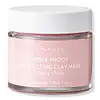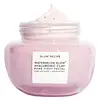What's inside
What's inside
 Key Ingredients
Key Ingredients

 Benefits
Benefits

 Concerns
Concerns

 Ingredients Side-by-side
Ingredients Side-by-side

Water
Skin ConditioningGlycerin
HumectantBentonite
AbsorbentCalamine
AbsorbentDipropylene Glycol
HumectantBetaine
HumectantKaolin
Abrasive1,2-Hexanediol
Skin ConditioningCI 77891
Cosmetic ColorantPrunus Serotina Fruit Extract
MaskingFragaria Chiloensis Fruit Extract
Skin ConditioningMelia Azadirachta Leaf Extract
Skin ConditioningCentella Asiatica Extract
CleansingPanthenol
Skin ConditioningGlycyrrhiza Uralensis Root Extract
Skin ConditioningScutellaria Baicalensis Root Extract
AstringentAllantoin
Skin ConditioningButylene Glycol
HumectantEclipta Prostrata Extract
Skin ConditioningCaprylic/Capric Triglyceride
MaskingStearic Acid
CleansingCetearyl Alcohol
EmollientPolyglyceryl-3 Methylglucose Distearate
EmulsifyingGlyceryl Stearate
EmollientMagnesium Aluminum Silicate
AbsorbentChlorphenesin
AntimicrobialXanthan Gum
EmulsifyingQuartz
AbrasiveCitric Acid
BufferingMoringa Oleifera Seed Oil
EmollientEthylhexylglycerin
Skin ConditioningButyrospermum Parkii Butter
Skin ConditioningTrisodium Ethylenediamine Disuccinate
Citrus Aurantium Amara Flower Oil
MaskingWater, Glycerin, Bentonite, Calamine, Dipropylene Glycol, Betaine, Kaolin, 1,2-Hexanediol, CI 77891, Prunus Serotina Fruit Extract, Fragaria Chiloensis Fruit Extract, Melia Azadirachta Leaf Extract, Centella Asiatica Extract, Panthenol, Glycyrrhiza Uralensis Root Extract, Scutellaria Baicalensis Root Extract, Allantoin, Butylene Glycol, Eclipta Prostrata Extract, Caprylic/Capric Triglyceride, Stearic Acid, Cetearyl Alcohol, Polyglyceryl-3 Methylglucose Distearate, Glyceryl Stearate, Magnesium Aluminum Silicate, Chlorphenesin, Xanthan Gum, Quartz, Citric Acid, Moringa Oleifera Seed Oil, Ethylhexylglycerin, Butyrospermum Parkii Butter, Trisodium Ethylenediamine Disuccinate, Citrus Aurantium Amara Flower Oil
Water
Skin ConditioningGlycerin
HumectantKaolin
AbrasiveStearyl Alcohol
EmollientHydroxypropyl Starch Phosphate
Bentonite
AbsorbentCaprylic/Capric Triglyceride
MaskingGlyceryl Stearate Se
EmulsifyingCitrullus Lanatus Fruit Extract
Skin ConditioningGluconolactone
Skin ConditioningHydrated Silica
AbrasiveSea Water
HumectantSalix Alba Bark Extract
AstringentSodium Stearoyl Lactylate
EmulsifyingXanthan Gum
EmulsifyingLactobacillus/Watermelon Fruit Ferment Extract
Skin ConditioningSodium Hyaluronate
HumectantHydrolyzed Sodium Hyaluronate
Skin ConditioningBambusa Arundinacea Stem Extract
Skin ConditioningLycium Barbarum Fruit Extract
AstringentLeuconostoc/Radish Root Ferment Filtrate
AntimicrobialCaprylyl Glycol
Emollient1,2-Hexanediol
Skin ConditioningCitric Acid
BufferingMaltodextrin
AbsorbentEclipta Prostrata Extract
Skin ConditioningGlucose
HumectantSodium Phytate
Silica
AbrasiveMelia Azadirachta Leaf Extract
Skin ConditioningPotassium Sorbate
PreservativeHexylene Glycol
EmulsifyingMoringa Oleifera Seed Oil
EmollientVaccinium Corymbosum Seed
AbrasiveHydroxyacetophenone
AntioxidantCarrageenan
CI 77891
Cosmetic ColorantPhenoxyethanol
PreservativeParfum
MaskingWater, Glycerin, Kaolin, Stearyl Alcohol, Hydroxypropyl Starch Phosphate, Bentonite, Caprylic/Capric Triglyceride, Glyceryl Stearate Se, Citrullus Lanatus Fruit Extract, Gluconolactone, Hydrated Silica, Sea Water, Salix Alba Bark Extract, Sodium Stearoyl Lactylate, Xanthan Gum, Lactobacillus/Watermelon Fruit Ferment Extract, Sodium Hyaluronate, Hydrolyzed Sodium Hyaluronate, Bambusa Arundinacea Stem Extract, Lycium Barbarum Fruit Extract, Leuconostoc/Radish Root Ferment Filtrate, Caprylyl Glycol, 1,2-Hexanediol, Citric Acid, Maltodextrin, Eclipta Prostrata Extract, Glucose, Sodium Phytate, Silica, Melia Azadirachta Leaf Extract, Potassium Sorbate, Hexylene Glycol, Moringa Oleifera Seed Oil, Vaccinium Corymbosum Seed, Hydroxyacetophenone, Carrageenan, CI 77891, Phenoxyethanol, Parfum
 Reviews
Reviews

Ingredients Explained
These ingredients are found in both products.
Ingredients higher up in an ingredient list are typically present in a larger amount.
1,2-Hexanediol is a synthetic liquid and another multi-functional powerhouse.
It is a:
- Humectant, drawing moisture into the skin
- Emollient, helping to soften skin
- Solvent, dispersing and stabilizing formulas
- Preservative booster, enhancing the antimicrobial activity of other preservatives
Bentonite is an aluminium phyllosilicate clay with great absorbent properties. The name 'bentonite' comes from the area where the largest source is found: Fort Benton, Wyoming.
As a clay, bentonite is often used to absorb excess oil and provide exfoliation. It has also been shown to have some antibacterial and anti-inflammatory properties. Studies show bentonite was effective at calming dermatitis from poison ivy and in diaper dermatitis of infants. Bentonite has also been shown to act as a barrier against toxic compounds on your skin.
Sunscreens containing bentonite display higher water resistance and stay on the skin for much longer. The sunscreens containing bentonite also show higher potency and UV light absorbtion.
Bentonite is naturally created from volcanic ash and several natural weathering/hydrothermal processes.
A common usage of bentonite is removing excess protein from white wines. Bentonite contains a property of being able to absorb large amounts of protein from aqueous solutions.
Phyllosilicate clay has a structure formed by sheets.
Learn more about BentoniteThis ingredient is an emollient, solvent, and texture enhancer. It is considered a skin-softener by helping the skin prevent moisture loss.
It helps thicken a product's formula and makes it easier to spread by dissolving clumping compounds.
Caprylic Triglyceride is made by combining glycerin with coconut oil, forming a clear liquid.
While there is an assumption Caprylic Triglyceride can clog pores due to it being derived from coconut oil, there is no research supporting this.
Learn more about Caprylic/Capric TriglycerideCi 77891 is a white pigment from Titanium dioxide. It is naturally found in minerals such as rutile and ilmenite.
It's main function is to add a white color to cosmetics. It can also be mixed with other colors to create different shades.
Ci 77891 is commonly found in sunscreens due to its ability to block UV rays.
Learn more about CI 77891Citric Acid is an alpha hydroxy acid (AHA) naturally found in citrus fruits like oranges, lemons, and limes.
Like other AHAs, citric acid can exfoliate skin by breaking down the bonds that hold dead skin cells together. This helps reveal smoother and brighter skin underneath.
However, this exfoliating effect only happens at high concentrations (20%) which can be hard to find in cosmetic products.
Due to this, citric acid is usually included in small amounts as a pH adjuster. This helps keep products slightly more acidic and compatible with skin's natural pH.
In skincare formulas, citric acid can:
While it can provide some skin benefits, research shows lactic acid and glycolic acid are generally more effective and less irritating exfoliants.
Most citric acid used in skincare today is made by fermenting sugars (usually from molasses). This synthetic version is identical to the natural citrus form but easier to stabilize and use in formulations.
Read more about some other popular AHA's here:
Learn more about Citric AcidThis ingredient is also known as Bhringaraj extract or False Daisy. It has skin conditioning properties and is rich in antioxidants.
Glycerin is already naturally found in your skin. It helps moisturize and protect your skin.
A study from 2016 found glycerin to be more effective as a humectant than AHAs and hyaluronic acid.
As a humectant, it helps the skin stay hydrated by pulling moisture to your skin. The low molecular weight of glycerin allows it to pull moisture into the deeper layers of your skin.
Hydrated skin improves your skin barrier; Your skin barrier helps protect against irritants and bacteria.
Glycerin has also been found to have antimicrobial and antiviral properties. Due to these properties, glycerin is often used in wound and burn treatments.
In cosmetics, glycerin is usually derived from plants such as soybean or palm. However, it can also be sourced from animals, such as tallow or animal fat.
This ingredient is organic, colorless, odorless, and non-toxic.
Glycerin is the name for this ingredient in American English. British English uses Glycerol/Glycerine.
Learn more about GlycerinKaolin is a clay. It is used for oil control and to help minimize pores. Like other clays, kaolin has the ability to absorb excess sebum or oil. This can help clean out pores and mattify the skin.
Some types of kaolin may have exfoliating properties. When water is added to kaolin, it becomes a paste with small abrasive particles.
Most kaolin is a white color, but may be pink/orange/red depending on where it comes from.
The name 'kaolin' comes from a Chinese village named 'Gaoling'. Kaolin clay comes from rocks rich in kaolinite. Kaolinite, the mineral, has a silicate layered structure. Kaolinite is formed from chemical weathering of aluminum siilicate minerals.
Besides skincare, kaolin is commonly used to make glossy paper, in ceramics, toothpaste, and as medicine to soothe stomach issues.
Learn more about KaolinMelia Azadirachta Leaf Extract is extract from the neem plant.
The leaves of this tree contain flavonoids and polyphenols. These two compounds are antioxidants, anti-inflammatory, and antibacterial. Further research is needed as to their effects when applied on skin.
Moringa Oleifera Seed Oil is the oil expressed from the seeds of Moringa oleifera plant. It is more commonly known as Moringa seed oil.
Moringa seeds have antioxidant, anti-inflammatory, and skin hydrating properties. These seeds are rich in oils, proteins, monounsaturated fats, and tocopherols.
As an emollient, moringa seed oil helps trap moisture in the skin by creating a film on top. This helps keep your skin hydrated and soft.
Many compounds in moringa seed oil are antioxidant and anti-inflammatory. These compounds include Vitamin E. , catechins, ferulic acid, and more.
Another compound found in Moringa seed oil is oleic acid.
Moringa trees are native to the Himalayan mountains.
This ingredient may not be fungal-acne safe.
Learn more about Moringa Oleifera Seed OilWater. It's the most common cosmetic ingredient of all. You'll usually see it at the top of ingredient lists, meaning that it makes up the largest part of the product.
So why is it so popular? Water most often acts as a solvent - this means that it helps dissolve other ingredients into the formulation.
You'll also recognize water as that liquid we all need to stay alive. If you see this, drink a glass of water. Stay hydrated!
Learn more about WaterXanthan gum is used as a stabilizer and thickener within cosmetic products. It helps give products a sticky, thick feeling - preventing them from being too runny.
On the technical side of things, xanthan gum is a polysaccharide - a combination consisting of multiple sugar molecules bonded together.
Xanthan gum is a pretty common and great ingredient. It is a natural, non-toxic, non-irritating ingredient that is also commonly used in food products.
Learn more about Xanthan Gum